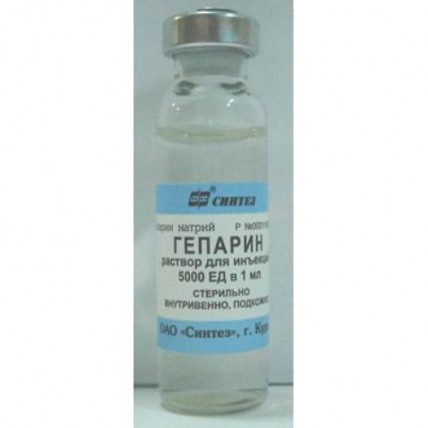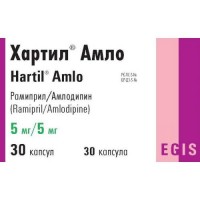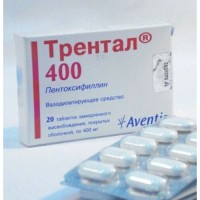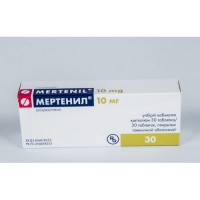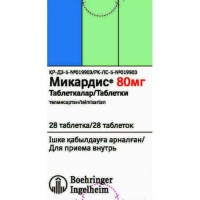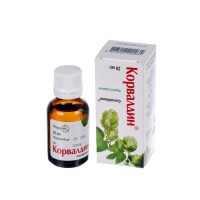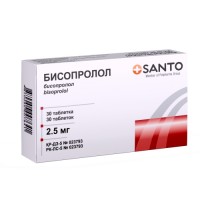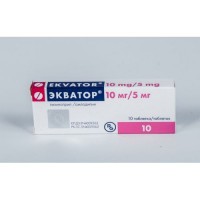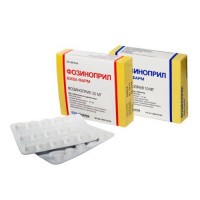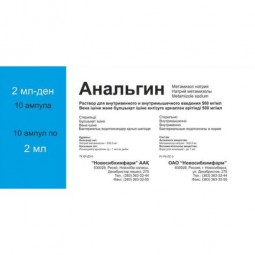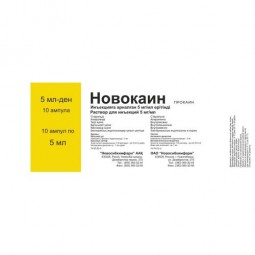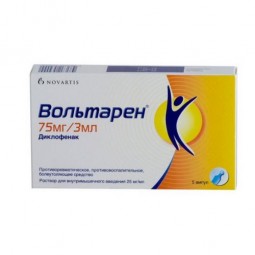Heparin 5000 IU / ml 5ml 1's injection
- $5.70
The instruction for medical use of HEPARIN medicine the Trade name HEPARIN the International unlicensed name Heparin Sodium Dosage Form Solution for injections, 5000 ME/ml Structure of 1 ml of solution contains active agent: heparin sodium 5000 ME, excipients: benzyl alcohol – 9.0 mg, sodium chloride, water for injections. The description Colourless or light yellow color transparent liquid Pharmacotherapeutic group the Drugs influencing a hemopoiesis and blood. Direct anticoagulants. Heparin. ATX B01AB01 code Pharmacological Pharmacokinetics Later properties of hypodermic introduction TCmax-of 4-5 h. Communication with proteins of blood plasma – up to 95%, distribution volume very small – 0.06 l/kg (does not leave a vascular bed because of strong linking with proteins of blood plasma). Heparin does not get through a placenta and into breast milk. It is intensively taken endothelial cells and cells of a mononuklearno-macrophagic system (cells of a reticuloendothelial system), concentrates in a liver and a spleen. At an inhalation method of administration (inhalation) it is absorbed by alveolar macrophages, an endothelium of capillaries, big blood and absorbent vessels: these cells are the main place of deposition of heparin from which about it is gradually released, maintaining necessary concentration in blood plasma. It is metabolized in a liver with participation of N-desulfamidazy and haparinase of thrombocytes joining in metabolism of heparin at later stages. Participation in metabolism of a platelet factor of IV (anti-heparin factor) and also linking of heparin with the system of macrophages explain a fast biological inactivation and short duration of action. Desulfatirovanny molecules under the influence of endoglycosidase of kidneys turn into low-molecular fragments. Elimination half-life of heparin – 1-6 h (on average – 1.5 h), increases in obesity, a liver and/or renal failure, decreases in a pulmonary embolism, infections, malignant tumors. It is allocated with kidneys, mainly in the form of inactive metabolites, and only at introduction of high doses the removal (to 50%) in not changed look is possible. It is not removed by means of a hemodialysis. The pharmacodynamics Anticoagulant of direct action, belongs to group of middlemolecular heparins, slows down formation of fibrin. The anticoagulating effect is found in vitro and in vivo, comes directly after intravenous use. The mechanism of effect of heparin is based first of all on its linking with antithrombin III – inhibitor of the activated blood-coagulation factors: thrombin, IXa, Xa, XIa, XIIa (the ability to inhibit thrombin and the activated factor of X is especially important). Heparin breaks transition of a prothrombin to thrombin, thrombin oppresses and stops formation of fibrin from fibrinogen, and also somewhat reduces aggregation of thrombocytes. Increases a renal blood stream, increases brain vascular resistance, reduces activity of brain hyaluronidase, activates lipoproteinlipase and possesses hypolipidemic action. Heparin reduces activity of surfactant in lungs, suppresses excessive synthesis of Aldosteronum in bark of adrenal glands, connects adrenaline, modulates reaction of ovaries to hormonal incentives, enhances activity of parathormone. As a result of interaction with enzymes can increase activity of a tyrosinehydroxylase of a brain, a pepsinogen, DNA polymerase and to reduce miozinovy ATFaza's activity, pyruvatekinases, RNA polymerases, pepsin. At patients with coronary heart disease (in a combination with acetylsalicylic acid) reduces risk of developing acute thromboses of coronary arteries, a myocardial infarction and sudden death. Reduces the frequency of repeated heart attacks and lethality of the patients who had a myocardial infarction. In high doses it is effective in pulmonary embolism and venous thrombosis, in small – for prevention of venous tromboemboliya, including after surgeries. At intravenous administration the fibrillation slows down almost at once, at intramuscular – in 15-30 min., at hypodermic – in 20-60 min., after inhalation at most of effect – in a day, duration of anti-coagulative effect respectively – 4-5, 6, 8 h and 1-2 weeks, the therapeutic effect – prevention of a thrombogenesis - remains much longer. The deficiency of antithrombin III in plasma or in the place of thrombosis can reduce antitrombotichesky effect of heparin. Indications - treatment of thromboembolic disturbances, such as deep vein thrombosis, acute arterial embolism or thrombosis, thrombophlebitis, embolism of coronary vessels - prevention of a deep vein thrombosis - prevention of a thrombembolia of a coronary artery at patients subject to this pathology - prevention of fibrillation during operations with use of extracorporal methods of blood circulation, when carrying out a hemodialysis HEPARIN to appoint the Route of administration and doses in the form of jet or faltering intravenous or subcutaneous injections. Before prescribing of drug it is necessary to define a blood clotting time, the thrombin and activated partial tromboplastinovy time, quantity of thrombocytes. For cultivation of HEPARIN to use only 0.9% chloride sodium solution. The adult in acute thrombosis to begin treatment with intravenous administration 10000 – 15000 ME HEPARIN under control of coagulability of venous blood, the thrombin and activated partial tromboplastinovy time. After that on 5000 – 10000 ME of HEPARIN to enter each 4-6 hours. At the same time the HEPARIN dose at which the blood clotting time increases by 2.5-3 times, and the activated partial tromboplastinovy time – by 1.5-2 times is considered adequate. For prevention of acute thrombosis to enter HEPARIN subcutaneously for 5000 ME each 6-8 hours. At the first phase of a syndrome of disseminate intravascular fibrillation (DVS) at adults heparin to fix subcutaneously a long time in a daily dose 2500-5000 ME under control of thrombin time. In 1-2 days prior to HEPARIN cancellation gradually to reduce a daily dose. Continuous intravenous infusion is the most effective route of administration of heparin, the best, than regular (periodic) injections as provides more stable hypocoagulation and less often causes bleedings. When carrying out extracorporal blood circulation enter in a dose of 140 - 400 ME/kg or on 1500-2000 ME on 500 ml of blood. At a hemodialysis enter intravenously 10000 ME in the beginning, then in the middle of the procedure – still 30000-50000 ME. For elderly people, especially women, doses have to be reduced. To children HEPARIN is entered intravenously by drop infusion: from 3 to 6 years – 600 ME/kg a day, from 6 to 15 years – 500 ME/kg a day under control of AChTV. Side effects the Most frequent by-effects – bleeding, reversible changes of activity of liver enzymes, reversible thrombocytopenia and various skin reactions. There are separate messages about generalized allergic reactions, necrosis of skin and a priapism. HEPARIN can cause thrombocytopenia directly or indirectly by development a thrombocyte - the aggregating antibodies. These phenomena are reversible after drug withdrawal. Often: thrombocytopenia type I Seldom: Thrombocytopenia type II, possibly immunoallergic nature. In certain cases II thrombocytopenia is followed by venous or arterial fibrinferments. - thrombocytopenia - skin necrosis - the arterial fibrinferments which are followed by development of gangrene, myocardial infarction, stroke - calcification of soft tissues - osteoporosis, spontaneous bone fractures - a hypoaldosteronism - a passing alopecia - increase in activity of hepatic transaminases - a bronchospasm, - collapse, - a Quincke's disease and anaphylactoid reactions Sometimes: - dizziness, - a headache, - nausea, - a loss of appetite, - vomiting, - diarrhea - a dermahemia, - medicinal fever, - a small tortoiseshell, - conjunctivitis, - rhinitis, - asthma, - cyanosis, - feeling of oppression, - fever, - a fever, - a skin itching and feeling of heat in soles, - local reactions: the irritation, pain, hyperaemia, a hematoma and ulcerations in the injection site, bleeding (the risk can be reduced to a minimum at careful assessment of contraindications, regular laboratory control of fibrillation and an exact dosage) - bleeding from digestive tract and uric ways, in the injection site, in the areas which are exposed to pressure from operational wounds and also hemorrhage in other bodies (adrenal glands, a yellow body, retroperitoneal space) of the Contraindication - hypersensitivity to heparin - tendency to bleedings (for example, hemophilia, thrombocytopenia, a vasculitis - aneurysm of vessels of a brain, the stratifying aortic aneurysm - a hemorrhagic stroke - an anti-phospholipidic syndrome - an injury (especially craniocereberal) - uncontrollable arterial hypertension - a proliferative diabetic retinopathy - an active form of tuberculosis - an acute and chronic leukosis - aplastic and hypoplastic anemias - digestive tract erosive cankers - the cirrhosis which is followed by a gullet varicosity - the menstrual period - the menacing abortion - childbirth (including recent) - recently carried out surgical interventions in the eyes, a brain, a prostate, a liver and bilious ways - a state after a puncture of a spinal cord - beremennost and the period of a lactation - premature - to newborns and children up to 3 years Medicinal interactions Anticoagulants of direct and indirect action strengthen effect of heparin. Antihistaminic drugs and drugs of a foxglove, tetracyclines, nicotine, nitroglycerine, corticotropin, thyroxine weaken anticoagulating effect of drug. The means reducing aggregation of thrombocytes (acetylsalicylic acid, a dextrin, phenylbutazone, an ibuprofen, a metindol, Dipiridamolum, hydroxychloroquine, fibrinolitik, ascorbic acid, ergot alkaloids, indometacin, Sulfinpyrazonum, probenetsid, cephalosporins, ketoromolak, epoprostinol, klopidogret, tiklopidin, streptokinase, administration of penicillin, Acidum etacrynicum, tsitostatik), at simultaneous therapy with heparin can cause hemorrhages therefore they need to be applied very carefully. The risk of hemorrhages also increases at combination therapy of heparin with ulcerogenic, immunosuppressive and thrombolytic drugs. HEPARIN can force out Phenytoinum, quinidine, propranolol, benzodiazepines and bilirubin from places of linking with proteins of plasma. At simultaneous use alkaline medicines, enaprilat, tricyclic antidepressants can contact heparin that leads to mutual decrease in efficiency. APF inhibitors, antagonists of angiotensin II: development of a hyperpotassemia is possible. Alcohol: simultaneous consumption of alcoholic drinks can increase risk of developing bleedings considerably. It is impossible to mix in one syringe with other medicines. Special instructions With care: to the persons having a polyvalent allergy (including bronchial asthma), arterial hypertension, at dental manipulations, diabetes, endocarditis, pericarditis, in the presence of an intrauterine contraceptive (VMK), active tuberculosis, radiation therapy, a liver failure, chronic kidney disease, advanced age (60 years, especially at the woman are more senior). HEPARIN cannot be entered intramusculary as possibly formation of hematomas in the injection site. Solution of heparin can get a yellow shade that does not change its activity or shipping. When prescribing heparin in the medical purposes its dose is selected depending on the APTT (the activated partial tromboplastinovy time) value. During use of heparin it is not necessary to enter intramusculary medicines and to carry out a biopsy of bodies. For cultivation of heparin use only 0.9% chloride sodium solution. Though heparin does not get into breast milk, appointment to his nursing mothers in some cases caused fast (during 2-4 weeks) development of osteoporosis and injury of a backbone. Features of influence of medicine on ability to run the vehicle or potentially dangerous mechanisms At use of the drug HEPARIN can arise: dizziness, a headache, nausea, in this regard for the period of treatment it is necessary to refrain from driving or potentially dangerous mechanisms. Overdose Symptoms: heavy hemorrhagic complications, bleedings. Treatment: depending on weight of a hemorrhagic complication it is necessary or to reduce a drug HEPARIN dose, or to cancel it. If after drug withdrawal HEPARIN bleeding proceeds, intravenously enter the antagonist of heparin – protamin sulfate (or chloride) (1 ml of protamin of sulfate neutralizes 100 ME heparins). Within 90 minutes after intravenous administration of the drug HEPARIN enter 50% of the calculated dose of protamin of sulfate, 50% – in the next 3 hours. At individual immunity and emergence of allergic complications HEPARIN is cancelled and appoint the desensibilizing means. In case of need continuations of anticoagulating therapy apply anticoagulants of indirect action. A form of release and packing Solution for injections on 5 ml in bottles. 5 bottles place in blister strip packaging. 1 blister strip packaging with the instruction for medical use in the state and Russian languages is placed in a pack from cardboard. 50 bottles with 1-5 iinstruktion on medical use in the state and Russian languages place in a box of cardboard for delivery to hospitals. To Store storage conditions in the place protected from light at a temperature not above 25 °C to Store out of children's reach! 4 years not to use a period of storage after an expiration date. Prescription status According to the prescription the Producer/packer of JSC Sintez 640008, Russian Federation, Kurgan, Konstitutsii Avenue, 7 Ph./fax (3522) 48-16-89 E-mail: real@kurgansintez.ru Website: www.kurgansintez.ru the Holder of the registration certificate of JSC Sintez, the Russian Federation the Address of the organization accepting in the territory of the Republic of Kazakhstan claims from consumers on quality of products and responsible for post-registration observation of safety of medicine in the territory of the Republic of Kazakhstan Decalog LLP, 050050, Republic of Kazakhstan, Almaty, Glazunov St., 41 A-1 ph. 2944221, ph. 8 7017315218 E-mail:
to Develop decalog@nur.kz
to Develop decalog@nur.kz
